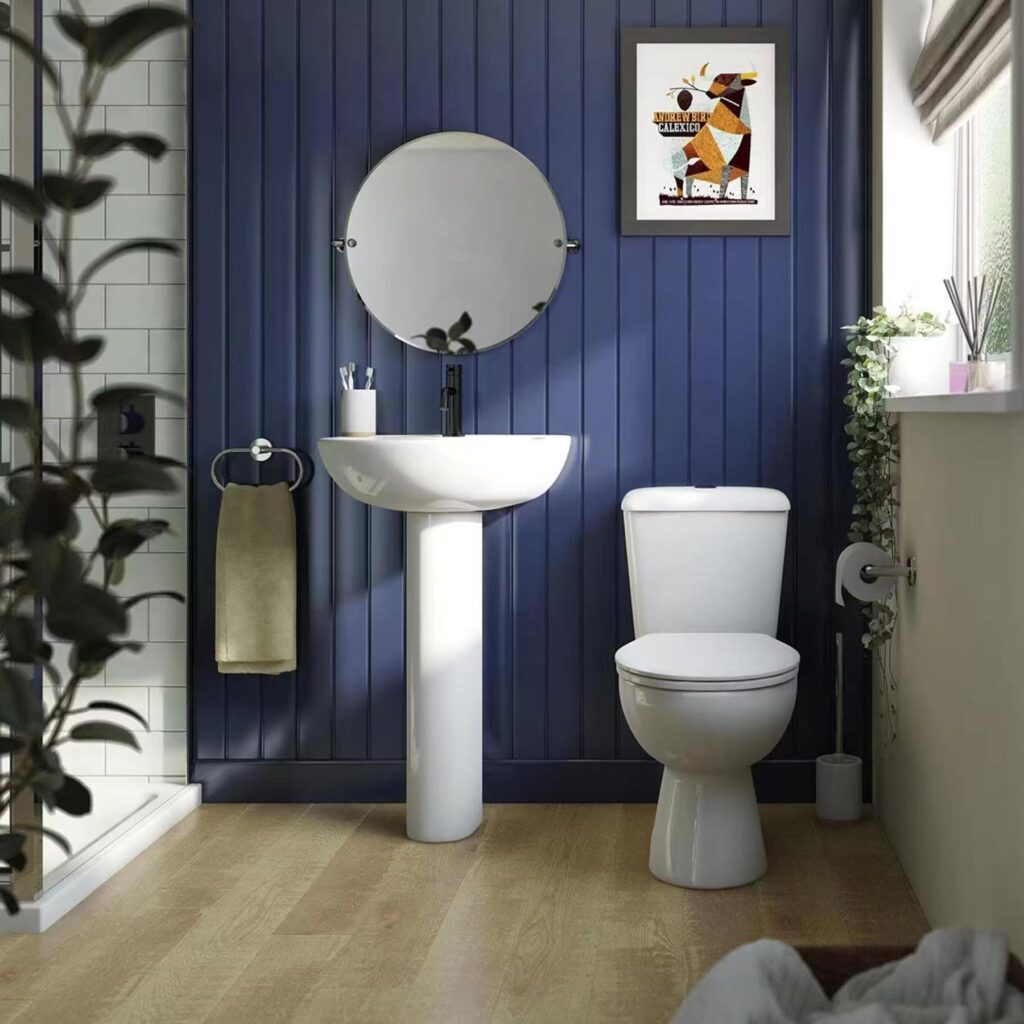מָבוֹא
When it comes to commercial bathroom projects, the choice between one-piece and two-piece ceramic toilets can significantly impact installation timelines, maintenance costs, and overall aesthetics. Procurement managers often grapple with balancing design preferences against logistical constraints and budget limitations.
At MFBath, we’ve seen firsthand how this decision can make or break a project’s efficiency. While two-piece toilets offer easier transport and potentially lower upfront costs, they often require more assembly time on-site. On the other hand, one-piece designs can streamline installation but may present challenges in tight spaces or with limited budgets.
This comprehensive guide cuts through the complexity, offering clear insights into the pros and cons of each ceramic toilet type. We’ll explore how factors like ease of cleaning, durability, and space optimization play crucial roles in selecting the right fixture for your commercial needs. By the end, you’ll have the knowledge to make a confident, project-aligned choice that balances both immediate requirements and long-term value.
Introduction to Ceramic Toilets for Commercial Projects
When it comes to outfitting commercial bathrooms, choosing the right ceramic toilet is a crucial decision that can impact the success of your project. As a “go-to” option for many businesses, ceramic toilets offer a perfect blend of durability, aesthetics, and functionality. In this chapter, we’ll explore why ceramic toilets are ideal for commercial use and provide an overview of key factors to consider when selecting the perfect fixtures for your space.
“Ceramic toilets are a cornerstone of commercial bathroom design, offering durability and style that can withstand high-traffic environments while maintaining a professional appearance.”
Why Ceramic Toilets Are Ideal for Commercial Use
Ceramic toilets have long been the preferred choice for commercial projects, and for good reason. These fixtures offer numerous benefits that make them well-suited for high-traffic environments:
- Durability: Ceramic toilets are built to last, withstanding frequent use and cleaning without showing signs of wear.
- Hygiene: The non-porous surface of ceramic is easy to clean and resistant to bacteria growth.
- Aesthetics: With a wide range of designs available, ceramic toilets can complement any commercial bathroom decor.
- Cost-effectiveness: While initial costs may vary, the long-term durability of ceramic toilets often results in a better return on investment.
Overview of One-Piece vs. Two-Piece Toilets
When selecting ceramic toilets for your commercial project, you’ll likely encounter two main types: one-piece and two-piece toilets. Each has its own set of advantages:
| תכונה | שירותים חד-פיסי | שירותים דו חלקים | Industry Average | MFBath Offering |
|---|---|---|---|---|
| Installation Time (minutes) | 45 | 60 | 55 | 40 |
| Average Lifespan (years) | 15-20 | 12-15 | 15 | 18-22 |
| Water Efficiency (gallons per flush) | 1.28 | 1.6 | 1.5 | 1.1 |
| Ease of Cleaning (1-10 scale) | 9 | 7 | 8 | 9.5 |
| Average Cost ($) | 350 | 250 | 300 | Customizable |
One-piece toilets offer a sleek, modern look and are generally easier to clean due to their seamless design. Two-piece toilets, consisting of a separate tank and bowl, are often more budget-friendly and easier to transport. Your choice will depend on factors such as budget, aesthetics, and maintenance preferences.
Key Procurement Considerations: Budget, Space, and Maintenance
When procuring ceramic toilets for your commercial project, consider these critical factors:
- Budget: Balance upfront costs with long-term value and durability.
- Space constraints: Ensure the chosen toilets fit comfortably within your bathroom layout.
- Maintenance requirements: Consider the ease of cleaning and potential repair needs.
- Water efficiency: Look for models that help conserve water without sacrificing performance.
- Compliance: Ensure toilets meet local building codes and accessibility standards.
Industry Trends in Commercial Bathroom Design for 2025
As we look towards 2025, several trends are shaping the future of commercial bathroom design:
- Touchless technology: Sensor-operated flush systems are becoming increasingly popular.
- Sustainability: Water-saving features and eco-friendly materials are in high demand.
- Smart toilets: Integration with building management systems for improved maintenance.
- Customization: More businesses are opting for tailored solutions to match their brand aesthetics.
At MFBath, we understand the complexities of choosing the right ceramic toilet for your commercial project. Our team of experts is dedicated to providing customizable solutions that meet your specific needs, ensuring a seamless procurement process for large-scale projects. With our diverse range of high-quality ceramic plumbing fixtures, including both one-piece and two-piece toilets, we’re committed to helping you create functional, stylish, and durable commercial bathrooms.

There are several key design differences between one-piece and two-piece ceramic toilets: 1. Construction: – One-piece: Tank and bowl are integrated into a single unit. – Two-piece: Tank and bowl are separate components. 2. Appearance: – One-piece: Sleeker, more modern look with no visible seam. – Two-piece: Traditional appearance with a visible seam between tank and bowl. 3. Size and Space: – One-piece: Generally more compact, ideal for smaller bathrooms. – Two-piece: Often taller and may require more space. 4. Cleaning: – One-piece: Easier to clean due to lack of crevices between tank and bowl. – Two-piece: May be more challenging to clean around the connection point. 5. Installation: – One-piece: Heavier and may be more difficult to install. – Two-piece: Lighter individual components, easier to maneuver during installation. 6. Repairs: – One-piece: If one part fails, the entire unit may need replacement. – Two-piece: Individual components can be replaced separately. 7. Cost: – One-piece: Generally more expensive. – Two-piece: Usually more affordable. 8. Customization: – One-piece: Limited options for bowl and tank combinations. – Two-piece: More flexibility in mixing different bowl and tank styles. Choosing between the two depends on factors like bathroom size, aesthetic preferences, budget, and maintenance considerations.
Installation and Logistics: Comparing One-Piece vs. Two-Piece Toilets
When it comes to outfitting commercial bathrooms, the choice between one-piece and two-piece ceramic toilets goes beyond just aesthetics. Installation processes and logistical considerations play a crucial role in project timelines, labor costs, and overall efficiency. Let’s dive into the nitty-gritty of these two popular options to help you make an informed decision for your next project.
“Understanding the installation and logistical differences between one-piece and two-piece ceramic toilets can significantly impact project timelines and budgets in commercial bathroom construction.”
Installation Process for One-Piece Toilets: Speed and Simplicity
One-piece toilets are known for their streamlined installation process. Here’s why they’re often a “slam dunk” for time-sensitive projects:
- Single-unit design eliminates the need for separate tank and bowl assembly
- Fewer connection points reduce the risk of leaks
- Pre-attached components simplify the mounting process
However, the unified structure of one-piece toilets can make them heavier and potentially more challenging to maneuver in tight spaces.
Installation Challenges for Two-Piece Toilets: Assembly Time
Two-piece toilets offer their own set of installation considerations:
- Separate tank and bowl components allow for easier transportation to the installation site
- Assembly requires more steps, potentially increasing installation time
- Multiple connection points need careful sealing to prevent leaks
While the initial setup might take longer, the modular nature of two-piece toilets can be advantageous for certain project layouts.
Logistics: Standard vs. Modular Shipment for Commercial Projects
The logistics of transporting ceramic toilets to your project site can significantly impact your bottom line. Let’s compare:
| Aspect | שירותים מקשה אחת | שירותים דו חלקים | Industry Average | MFBath Solution |
|---|---|---|---|---|
| Shipping Volume (cu. ft/unit) | 8 | 6 | 7 | 5.5 |
| Units per Standard Pallet | 4 | 6 | 5 | 7 |
| Average Shipping Cost ($/unit) | $45 | $35 | $40 | $30 |
| Breakage Rate During Transit | 2% | 3% | 2.5% | 1% |
| Assembly Time on Site (min/unit) | 30 | 45 | 40 | 25 |
MFBath’s innovative packaging solutions optimize shipping efficiency for both types, reducing costs and environmental impact.
Impact of Toilet Type on Project Timelines and Budgets
Choosing between one-piece and two-piece toilets can have ripple effects throughout your project:
- Labor Costs: One-piece toilets often require less installation time, potentially reducing labor expenses.
- Material Handling: Two-piece toilets offer more flexibility in navigating tight spaces during installation.
- Replacement Parts: Two-piece designs allow for easier and often cheaper component replacements.
- Project Flexibility: Two-piece toilets provide more options for mixing and matching components to meet specific project needs.
At MFBath, we understand the complexities of large-scale commercial projects. Our modular shipment options for two-piece toilets can significantly reduce logistics costs, while our efficiently designed one-piece toilets save on labor for time-sensitive installations. We’re committed to providing ceramic plumbing fixtures that not only meet your aesthetic and functional requirements but also align with your project timelines and budgets.
When considering how to install a ceramic toilet, remember that the choice between one-piece and two-piece models extends far beyond the bathroom walls. It impacts everything from shipping logistics to on-site assembly time. By carefully weighing these factors, you can make an informed decision that best suits your project’s unique needs and constraints.

When considering ceramic toilets for commercial bathrooms, it’s important to look at both upfront costs and long-term value. Here’s a breakdown: One-piece ceramic toilets: – Higher initial cost ($300-$600) – Lower installation cost ($150-$300) – Fewer seams, reducing potential for leaks – Easier to clean and maintain – Longer lifespan (15-30 years) Two-piece ceramic toilets: – Lower initial cost ($200-$400) – Higher installation cost ($200-$400) – More seams, potentially requiring more maintenance – Still durable, but may have a shorter lifespan (10-20 years) Both types offer benefits of ceramic material: – Resistant to scratches, stains, and fading – Withstand harsh cleaning chemicals – Less prone to cracking or chipping Long-term value considerations: – Water efficiency (look for models using 1.28 gallons per flush or less) – Maintenance costs over time – Durability in high-traffic areas For commercial projects, consider: – Budget constraints vs. long-term savings – Scale of the project (two-piece may be more cost-effective for large-scale installations) – Specific needs of the facility (e.g., ease of cleaning, expected usage) Ultimately, while one-piece toilets may have a higher upfront cost, their durability and ease of maintenance often result in better long-term value for commercial settings. However, high-quality two-piece models can also be a good choice, especially for projects with tight initial budgets.
Making the Right Choice for Your Commercial Project
Selecting the ideal ceramic toilet for your commercial project is a decision that requires careful consideration of various factors. As a procurement manager, your choice can significantly impact the success and longevity of your bathroom installations. Let’s dive into the key aspects you should evaluate to make an informed decision.
“Choosing the right ceramic toilet for your commercial project involves balancing immediate needs with long-term value, ensuring a solution that stands the test of time and usage.”
Assessing Project Needs: Space, Budget, and Traffic
Before making a choice between one-piece and two-piece toilets, it’s crucial to assess your project’s specific requirements:
- Space constraints: One-piece toilets often have a smaller footprint, ideal for compact bathrooms.
- Budget considerations: Two-piece toilets generally offer more budget-friendly options.
- Expected traffic: High-traffic areas may benefit from the durability of one-piece designs.
Comparing Features: Water Efficiency, Ease of Cleaning, and Aesthetics
Let’s break down the key features to consider when choosing your ceramic toilet:
| תכונה | שירותים חד-פיסי | שירותים דו חלקים | Industry Standard | MFBath Offering |
|---|---|---|---|---|
| Water Efficiency (GPF) | 1.28 | 1.6 | 1.6 | 1.1 |
| Cleaning Time (minutes) | 5 | 8 | 7 | 4 |
| Design Versatility (1-10) | 8 | 7 | 7.5 | 9 |
| Average Lifespan (years) | 15-20 | 10-15 | 12-18 | 18-25 |
| Maintenance Cost ($/year) | 50 | 75 | 65 | 40 |
MFBath’s offerings consistently outperform industry standards, providing superior efficiency and longevity.
Procurement Tips: Sourcing Reliable Ceramic Toilets
To ensure you’re getting the best value for your investment, consider these procurement tips:
- Request samples to assess quality and finish in person
- Check for certifications (e.g., WaterSense for water efficiency)
- Inquire about bulk pricing for large-scale projects
- Consider the availability of replacement parts
- Review warranty terms and after-sales support
Why MF Bath is a Trusted Partner for Commercial Bathrooms
At MFBath, we understand the complexities of commercial bathroom projects. Here’s why we’re the “ace in the hole” for procurement managers:
- Comprehensive range of ceramic plumbing fixtures to suit various project needs
- Customizable solutions to align with your specific requirements
- Expert support throughout the procurement and installation process
- Commitment to quality, backed by CE certification
- Innovative designs that balance aesthetics with functionality
When deciding which is better, one-piece or two-piece toilet, remember that the answer depends on your unique project needs. One-piece toilets excel in ease of cleaning and sleek aesthetics, while two-piece options offer more flexibility and often a lower initial cost. Both types of ceramic toilets from MFBath provide excellent durability and long-term value, ensuring your commercial bathroom stands the test of time.
By carefully considering your project’s specific requirements and leveraging the expertise of trusted suppliers like MFBath, you can make an informed decision that balances immediate needs with long-term value. Our team is here to guide you through the selection process, ensuring you choose the perfect ceramic toilet design options for your commercial project.


מַסְקָנָה
After years in the sanitary ware industry, I’ve seen firsthand how the right ceramic toilet can make or break a commercial project. Whether you opt for the sleek, easy-to-clean design of a one-piece or the budget-friendly flexibility of a two-piece, the key is matching your choice to your project’s unique needs.
At MFBath, we’ve made it our mission to provide top-notch ceramic solutions that go beyond just function. Our CE-certified products are designed to be the **”whole package”** – balancing efficiency, durability, and style. Remember, investing in quality sanitary ware isn’t just about today’s installation; it’s about ensuring long-term value and performance for your commercial spaces.
As you move forward with your project, consider not just the upfront costs, but the long-term benefits each option brings to the table. And remember, we’re here to support you every step of the way, from selection to maintenance, ensuring your commercial bathrooms stand the test of time.
שאלות נפוצות
-
Q1: What are the different types of ceramic toilets?
A1: The two main types of ceramic toilets are one-piece and two-piece models. One-piece toilets have a seamless design for easier cleaning, while two-piece toilets have a separate tank and bowl, which can be easier to transport and install.
-
Q2: What are the advantages of ceramic toilets?
A2: Ceramic toilets offer durability, easy cleaning, and a resistance to stains, scratches, and chips. They also come in various styles and designs, making them versatile for any bathroom aesthetic.
-
Q3: Are ceramic toilets easy to install?
A3: Yes, ceramic toilets are generally considered easy to install. However, having a professional plumber can ensure proper fitting and avoid any plumbing issues.
-
Q4: What is the cost difference between one-piece and two-piece ceramic toilets?
A4: One-piece ceramic toilets typically cost more than two-piece models due to their design and ease of cleaning. Prices can vary based on brand and features, but consumers often see one-piece toilets as a long-term investment.
-
Q5: How do ceramic toilets compare to porcelain toilets?
A5: Ceramic toilets are made from fired clay, while porcelain toilets are a type of ceramic that has additional ingredients, making them denser and more durable. Porcelain toilets usually have a superior finish and are less porous but may come at a higher price.
-
Q6: What maintenance do ceramic toilets require?
A6: Ceramic toilets require minimal maintenance. Regular cleaning with non-abrasive cleaners helps prevent stains and buildup. It’s also important to periodically check for leaks and ensure proper flushing.
-
Q7: What are the installation requirements for ceramic toilets?
A7: Installation requires basic plumbing tools and skills. Standard rough-in measurements (usually 12 inches) must match, and the floor must be level. Water supply lines and a wax seal are also necessary for proper function.
-
Q8: What are some popular brands of ceramic toilets?
A8: Popular brands of ceramic toilets include Kohler, American Standard, Toto, and Duravit. These brands offer various styles and features suited for different bathroom needs.
קישורים חיצוניים
- Ceramic vs. Porcelain Toilet: Performance Comparison
- Vitreous China vs. Ceramic vs. Porcelain toilets: Which is better?
- Ceramic vs Porcelain Toilet: Choosing the Throne for Your Bathroom
- Toilets: Contemporary, Traditional & Transitional – Studio KOHLER
- Ceramic Toilets at Lowe’s
- Toilets: High Quality, Modern & Hygienic | Duravit
- CTM South Africa | Buy Toilets Online






